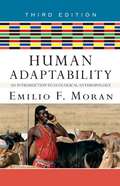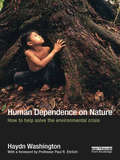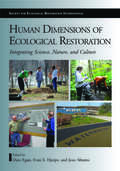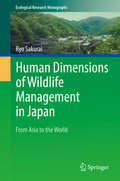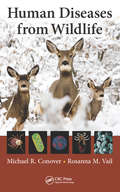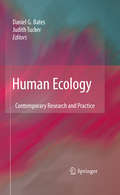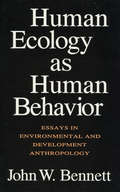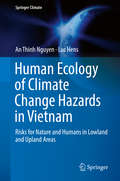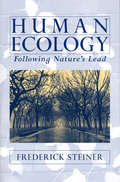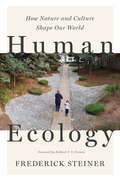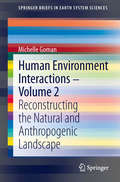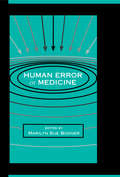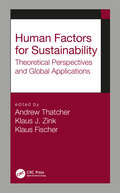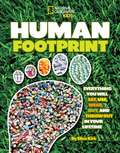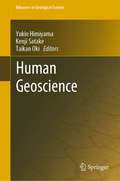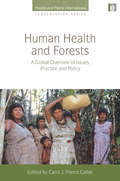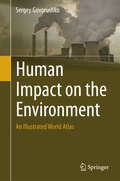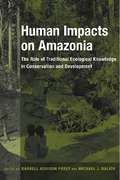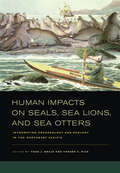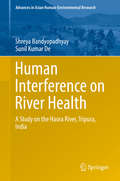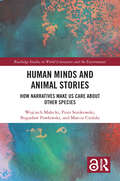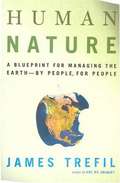- Table View
- List View
Human Adaptability
by Emilio F. MoranDesigned to help students understand the multiple levels at which human populations respond to their surroundings, this essential text offers the most complete discussion of environmental, physiological, behavioral, and cultural adaptive strategies available. Among the unique features that make Human Adaptability outstanding as both a textbook for students and a reference book for professionals are a complete discussion of the development of ecological anthropology and relevant research methods; the use of an ecosystem approach with emphasis on arctic, high altitude, arid land, grassland, and tropical rain forest environments; an extensive bibliography on ecological anthropology; and a comprehensive glossary of technical terms. Entirely new to the third edition are chapters on urban sustainability and methods of spatial analysis, with enhanced emphasis throughout on the role of gender in human-adaptability research and on global environmental issues as they affect particular ecosystems. In addition, brand-new sections in each chapter guide students to websites that provide access to relevant material, complement the text's coverage of biomes, and suggest ways to become active in environmental issues.
Human Adaptability
by Emilio F. MoranDesigned to help students understand the multiple levels at which human populations respond to their surroundings, this essential text offers the most complete discussion of environmental, physiological, behavioral, and cultural adaptive strategies available. Among the unique features that make Human Adaptability outstanding as both a textbook for students and a reference book for professionals are a complete discussion of the development of ecological anthropology and relevant research methods; the use of an ecosystem approach with emphasis on arctic, high altitude, arid land, grassland, tropical rain forest, and urban environments; an extensive and updated bibliography on ecological anthropology; and a comprehensive glossary of technical terms. Entirely new to the third edition are chapters on urban sustainability and methods of spatial analysis, with enhanced emphasis throughout on the role of gender in human-adaptability research and on global environmental change as it affects particular ecosystems. In addition, new sections in each chapter guide students to websites that provide access to relevant material, complement the text’s coverage of biomes, and suggest ways to become active in environmental issues.
Human Dependence on Nature: How to Help Solve the Environmental Crisis
by Haydn WashingtonHumanity is dependent on Nature to survive, yet our society largely acts as if this is not the case. The energy that powers our very cells, the nutrients that make up our bodies, the ecosystem services that clean our water and air; these are all provided by the Nature from which we have evolved and of which we are a part. This book examines why we deny or ignore this dependence and what we can do differently to help solve the environmental crisis. Written in an accessible and engaging style, Haydn Washington provides an excellent overview of humanity’s relationship with Nature. The book looks at energy flow, nutrient cycling, ecosystem services, ecosystem collapse as well as exploring our psychological and spiritual dependency on nature. It also examines anthropocentrism and denial as causes of our unwillingness to respect our inherent dependence on the natural environment. The book concludes by bringing these issues together and providing a framework for solutions to the environmental crisis.
Human Dimensions of Ecological Restoration: Integrating Science, Nature, and Culture (Science Practice Ecological Restoration)
by Jesse Abrams Evan E. Hjerpe Dave EganHuman Dimensions of Ecological Restoration takes an interdisciplinary look at the myriad human aspects of ecological restoration. In twenty-six chapters written by experts from around the world, it provides practical and theoretical information, analysis, models, and guidelines for optimizing human involvement in ecological restoration projects. The book delves into the often-neglected aspects of ecological restoration that ultimately make the difference between projects that are successfully executed and maintaned with the support of informed, engaged citizens, and those that are unable to advance past the conceptual stage due to misunderstandings or apathy. The lessons contained will be valuable to restoration veterans and greenhorns alike, scholars and students in a range of fields, and individuals who care about restoring their local lands and waters.
Human Dimensions of Wildlife Management in Japan: From Asia to the World (Ecological Research Monographs)
by Ryo SakuraiThis book discusses the findings of research on the human dimensions of wildlife management conducted in Japan, demonstrating how such research and approaches have contributed to mitigating human-wildlife conflicts.Human-wildlife conflicts, including agricultural and property damage as well as occasional casualties, are a global problem for which local residents, managers, and stakeholders around the world are struggling to find solutions. Human dimensions of wildlife management (HDW) is an academic field developed in North America in the 1970s to gather information on the social aspects of human-wildlife issues to help wildlife managers and stakeholders implement effective decision-making measures. However, HDW is not widely recognized or applied outside North America, and few studies have investigated whether HDW approaches would be effective in different cultural settings.This is the first book written in English to introduce the HDW theories and practices implemented in Asia. Presenting innovative approaches and research techniques, as well as tips on how to introduce HDW methods into culturally different societies, it is a valuable resource not only for researchers and students in this field, but also for government officials/managers, NGOs, residents and other stakeholders who are affected by human-wildlife conflicts around the globe.
Human Dimensions of Wildlife Management in North America
by Daniel J. Decker Tommy L. Brown William F. SiemerThe term human dimensions covers a broad set of ideas and practices, including economic and social values, individual and group behavior, citizen involvement in planning and implementation of management, and communication.
Human Diseases from Wildlife
by Michael R. Conover Rosanna M. VailHuman Diseases from Wildlife presents information on the most prevalent and serious zoonotic diseases in the US and Canada, some of which have been national headline news like anthrax, influenza, and West Nile virus. Diseases that are caused by pathogens with the ability to infect both humans and animals are known as zoonotic diseases, which litera
Human Ecology
by Judith Tucker Daniel G. BatesThis comprehensive sourcebook on human ecology combines 25 source articles published in the journal Human Ecology, enhanced with new research updates and thematic commentary. Intended as a follow up to Case Studies in Human Ecology, this volume includes an entirely new group of articles, with the same accessible, comprehensive coverage that made Case Studies so popular. Human Ecology: Research and Practice covers four important areas: Philosophy, Theory and Methods; Changing Subsistence Practices; Agricultural Intensification and Population Dynamics; and, Common Property Resources and Conservation. As a group, these articles represent the major contributions to the study of Human Ecology since the publication of the previous volume. Each article includes a concise introduction by the Editor, giving necessary and thoughtful context. The volume covers an overview of human ecology as a field within environmental studies, new directions in contemporary research, new methods and techniques, and cultural landscapes. Anyone studying human ecology, environmental studies, landscape studies, or population dynamics, particularly key issues such as conservation and globalization will find this comprehensive reader a valuable resource.
Human Ecology as Human Behavior: Essays in Environmental and Developmental Anthropology
by John W. BennettHuman interaction with the natural environment has a dual character. By turning increasing quantities of natural substances into physical resources, human beings might be said to have freed themselves from the constraints of low-technology survival pressures. However, the process has generated a new dependence on nature in the form of complex "socionatural systems," as Bennett calls them, in which human society and behavior are so interlocked with the management of the environment that small changes in the systems can lead to disaster. Bennett's essays cover a wide range: from the philosophy of environmentalism to the ecology of economic development; from the human impact on semi-arid lands to the ecology of Japanese forest management. This expanded paperback edition includes a new chapter on the role of anthropology in economic development.Bennett's essays exhibit an underlying pessimism: if human behavior toward the physical environment is the distinctive cause of environmental abuse, then reform of current management practices offers only temporary relief; that is, conservationism, like democracy, must be continually reaffirmed. Clearly presented and free of jargon, Human Ecology as Human Behavior will be of interest to anthropologists, economists, and environmentalists.
Human Ecology of Climate Change Hazards in Vietnam: Risks for Nature and Humans in Lowland and Upland Areas (Springer Climate)
by An Thinh Nguyen Luc HensThis book analyzes climate change associated effects in the mountainous and coastal environments of Vietnam. The scope of the book allows international comparisons to be made between these two affected areas and other similarly affected locations under constant environmental pressure. Frequent and intense climate change hazards are described, along with a wider context of integrated interpretations, socioeconomic implications and policy responses. The book reports on original research combining methodologies from the natural sciences with approaches in human sciences, providing an interdisciplinary human ecological context to analyze similar situations worldwide. The book is structured in four parts. The first part offers background information, and details the human ecological framework. The geography of the analyzed regions is discussed to reflect the environmental and socioeconomic context of Vietnam's coasts and mountains. The second part addresses the coast of Central Vietnam. The effects of tropical storms, floods, rising sea levels and coastal erosion in Ky Anh are studied to highlight the impacts on the local population and its development perspectives. The third part focuses on the uplands of Northern Vietnam. The effects of cyclones, heavy rains, floods, flash floods, and landslides in the Van Chan Mountains are studied to compare the biophysical and socioeconomic impacts. Part four makes policy recommendations in building resilient landscapes and green cities, and discusses the potential implications of findings for practice in Vietnam. The book addresses a wide array of researchers, geography and economics students, consultants and decision makers interested in the actual status and the likely developments on the physical, socioeconomic and mitigation and adaptation attitudes and policies of climate change associated effects.
Human Ecology: A Theory of Community Structure
by Amos H. HawleyThis volume attempts to develop a full and coherent theory of human ecology. Working from the assumption that there is continuity in the life patterns of all organic forms, the argument begins with the contributions of plant and animal ecologists and seeks to elaborate the logical implications of general ecological theory. This leads to the investigation of a fundamental yet long neglected sociological problem, namely, the nature and development of community structure.
Human Ecology: Following Nature's Lead
by Frederick R. Steiner Richard T.T. FormanIn Human Ecology, noted landscape planner Frederick Steiner presents a historical and analytical examination of how humans interact with each other as well as with other organisms and their surroundings.
Human Ecology: How Nature and Culture Shape Our World
by Frederick SteinerHumans have always been influenced by natural landscapes, and always will be--even as we create ever-larger cities and our developments fundamentally change the nature of the earth around us. In Human Ecology, noted city planner and landscape architect Frederick Steiner encourages us to consider how human cultures have been shaped by natural forces, and how we might use this understanding to contribute to a future where both nature and people thrive. Human ecology is the study of the interrelationships between humans and their environment, drawing on diverse fields from biology and geography to sociology, engineering, and architecture. Steiner admirably synthesizes these perspectives through the lens of landscape architecture, a discipline that requires its practitioners to consciously connect humans and their environments. After laying out eight principles for understanding human ecology, the book's chapters build from the smallest scale of connection--our homes--and expand to community scales, regions, nations, and, ultimately, examine global relationships between people and nature. In this age of climate change, a new approach to planning and design is required to envision a livable future. Human Ecology provides architects, landscape architects, urban designers, and planners--and students in those fields-- with timeless principles for new, creative thinking about how their work can shape a vibrant, resilient future for ourselves and our planet.
Human Environment Interactions - Volume 2
by Michelle GomanThe Holocene is unique when compared to earlier geological time in that humans begin to alter and manipulate the natural environment to their own needs. Domestication of crops and animals and the resultant intensification of agriculture lead to profound changes in the impact humans have on the environment. Conversely, as human populations began to increase geologic and climatic factors begin to have a greater impact on civilizations. To understand and reconstruct the complex interplay between humans and the environment over the past ten thousand years requires examination of multiple differing but interconnected aspects of the environment and involves geomorphology, paleoecology, geoarchaeology and paleoclimatology. These Springer Briefs volumes examine the dynamic interplay between humans and the natural environment as reconstructed by the many and varied sub-fields of the Earth Sciences.
Human Error in Medicine (Human Error and Safety)
by Marilyn Sue BognerThis edited collection of articles addresses aspects of medical care in which human error is associated with unanticipated adverse outcomes. For the purposes of this book, human error encompasses mismanagement of medical care due to: * inadequacies or ambiguity in the design of a medical device or institutional setting for the delivery of medical care; * inappropriate responses to antagonistic environmental conditions such as crowding and excessive clutter in institutional settings, extremes in weather, or lack of power and water in a home or field setting; * cognitive errors of omission and commission precipitated by inadequate information and/or situational factors -- stress, fatigue, excessive cognitive workload. The first to address the subject of human error in medicine, this book considers the topic from a problem oriented, systems perspective; that is, human error is considered not as the source of the problem, but as a flag indicating that a problem exists. The focus is on the identification of the factors within the system in which an error occurs that contribute to the problem of human error. As those factors are identified, efforts to alleviate them can be instituted and reduce the likelihood of error in medical care. Human error occurs in all aspects of human activity and can have particularly grave consequences when it occurs in medicine. Nearly everyone at some point in life will be the recipient of medical care and has the possibility of experiencing the consequences of medical error. The consideration of human error in medicine is important because of the number of people that are affected, the problems incurred by such error, and the societal impact of such problems. The cost of those consequences to the individuals involved in medical error, both in the health care providers' concern and the patients' emotional and physical pain, the cost of care to alleviate the consequences of the error, and the cost to society in dollars and in lost personal contributions, mandates consideration of ways to reduce the likelihood of human error in medicine. The chapters were written by leaders in a variety of fields, including psychology, medicine, engineering, cognitive science, human factors, gerontology, and nursing. Their experience was gained through actual hands-on provision of medical care and/or research into factors contributing to error in such care. Because of the experience of the chapter authors, their systematic consideration of the issues in this book affords the reader an insightful, applied approach to human error in medicine -- an approach fortified by academic discipline.
Human Factors for Sustainability: Theoretical Perspectives and Global Applications
by Klaus J. Zink Andrew Thatcher Klaus FischerThis book deals with the central question of how human factors and ergonomics (HFE) might contribute to solutions for the more sustainable development of our world. The contents of the book are highly compatible with the recent political agenda for sustainable development as well as with sustainability research from other disciplines. <P><P>The book aims to summarize and profile the various empirical and theoretical work arising from the field of “Human Factors and Sustainable Development” in the last decade. The book gives a systematic overview of relevant theoretical concepts, their underlying philosophies, as well as global application fields and case studies.
Human Footprint: Everything you will eat, use, wear, buy, and throw out in your Lifetime (National Geographic Kids)
by Ellen KirkMakes you want to step more lightly on the planet! Perfectly timed for Earth Day, this book doesn't preach or judge, but simply shows kids—in an exciting, visual way—how humans interact with the environment and how we can lessen our impact.
Human Geoscience (Advances in Geological Science)
by Taikan Oki Yukio Himiyama Kenji SatakeThis book is a product of the joint efforts of interdisciplinary academic fields under the integrative framework of human geoscience. Human geoscience is a new genre of geoscience concerned with the natural phenomena that occur on the surface of the Earth and their relations with human activities. It therefore has connections with many fields of geoscience, namely, physical geography, geomorphology, geology, soil science, sedimentology, seismology, volcanology, meteorology, climatology, oceanography, and hydrology. It also has strong links to the humanities, social sciences, agricultural sciences, and engineering related to disaster prevention or mitigation. All these disciplines are important fields for understanding disasters and global environmental problems and for evaluating the associated risks comprehensively, then proposing mitigation strategies.The volume is designed for those who may not necessarily have a geoscience background but have broad scientific interest in understanding the causes, mechanisms, and consequences of geo-disasters and global environmental problems and wish to make the world more sustainable on that basis. The book consists of six parts: I. Introduction, II. Earth Surface Realms, III. Natural Resources and Society, IV. Natural Hazards and Society, V. Global Environmental Problems, and VI. Global Sustainability Programmes and Human Geoscience, which discusses the contribution of this field of science to a new comprehensive framework for global sustainability.
Human Health and Forests: A Global Overview of Issues, Practice and Policy (People and Plants International Conservation)
by Carol J. Pierce ColferHundreds of millions of people live and work in forests across the world. One vital aspect of their lives, yet largely unexamined, is the challenge of protecting and enhancing the unique relationship between the health of forests and the health of people. This book, written for a broad audience, is the first comprehensive introduction to the issues surrounding the health of people living in and around forests, particularly in Asia, South America and Africa. Part I is a set of synthesis chapters, addressing policy, public health, environmental conservation and ecological perspectives on health and forests (including women and child health, medicinal plants and viral diseases such as Ebola, SARS and Nipah Encephalitis). Part II takes a multi-lens approach to lead the reader to a more concrete and holistic understanding. It features case studies from around the world that cover important issues such as the links between HIV/AIDS and the forest sector, and between diet and health. Part III looks at the specific challenges to health care delivery in forested areas, including remoteness and the integration of traditional medicine with modern health care. The generous use of boxes with specific examples adds layers of depth to the analyses. The book concludes with a synthesis designed for use by practitioners and policymakers to work with forest dwellers to improve their health and their ecosystems. This book is a vital addition to the knowledge base of all professionals, academics and students working on forests, natural resources management, health and development worldwide. Published with CIFOR and People and Plants International
Human Impact on the Environment
by Sergey GovorushkoThis atlas presents a collection of geographical maps showing human impact on the environment. A wide variety of human impacts are discussed, ranging from the energy, mining, transport and agricultural industries as well as less visible impacts such as those of space exploration. This book is a highly illustrated atlas with 300 photos from 70 countries. Each map is accompanied by a short description of each human impact and its effect on the specific natural environment.
Human Impacts on Amazonia: The Role of Traditional Ecological Knowledge in Conservation and Development (Biology and Resource Management Series)
by Michael Balick Darrell PoseyFrom the pre-Columbian era to the present, native Amazonians have shaped the land around them, emphasizing utilization, conservation, and sustainability. These priorities stand in stark contrast to colonial and contemporary exploitation of Amazonia by outside interests. With essays from environmental scientists, botanists, and anthropologists, this volume explores the various effects of human development on Amazonia. The contributors argue that by protecting and drawing on local knowledge and values, further environmental ruin can be avoided.
Human Impacts on Seals, Sea Lions, and Sea Otters: Integrating Archaeology and Ecology in the Northeast Pacific
by Torben C. Rick Todd J. BrajeFor more than ten thousand years, Native Americans from Alaska to southern California relied on aquatic animals such as seals, sea lions, and sea otters for food and raw materials. Archaeological research on the interactions between people and these marine mammals has made great advances recently and provides a unique lens for understanding the human and ecological past. Archaeological research is also emerging as a crucial source of information on contemporary environmental issues as we improve our understanding of the ancient abundance, ecology, and natural history of these species. This groundbreaking interdisciplinary volume brings together archaeologists, biologists, and other scientists to consider how archaeology can inform the conservation and management of pinnipeds and other marine mammals along the Pacific Coast.
Human Interference on River Health
by Shreya Bandyopadhyay Sunil Kumar DeThis book examines in detail the health of India's Haora River, which is of vital importance as the lifeline of Agartala, the Capital City of Tripura. From its source in the Baramura Hills, the river debouches onto the rolling plains of Chandrasadhubari. Thousands of people between Chandrasadhubari and the boundary of Bangladesh have settled along the riverbanks and are directly dependent on the river. Since the 1970s the ever-growing population of the Haora River basin has been exerting tremendous pressure on the river. Several anthropogenic activities affect the river, increasing sedimentation and pollution, and are leading the Haora River toward its dying phase. This book presents the problems related to the overall health of the Haora River and discusses some proposals for restoring the ecological balance and geo-political stability of this strategically important part of the country.
Human Minds and Animal Stories: How Narratives Make Us Care About Other Species (Routledge Studies in World Literatures and the Environment)
by Wojciech Małecki Piotr Sorokowski Bogusław Pawłowski Marcin CieńskiThe power of stories to raise our concern for animals has been postulated throughout history by countless scholars, activists, and writers, including such greats as Thomas Hardy and Leo Tolstoy. This is the first book to investigate that power and explain the psychological and cultural mechanisms behind it. It does so by presenting the results of an experimental project that involved thousands of participants, texts representing various genres and national literatures, and the cooperation of an internationally-acclaimed bestselling author. Combining psychological research with insights from animal studies, ecocriticism and other fields in the environmental humanities, the book not only provides evidence that animal stories can make us care for other species, but also shows that their effects are more complex and fascinating than we have ever thought. In this way, the book makes a groundbreaking contribution to the study of relations between literature and the nonhuman world as well as to the study of how literature changes our minds and society. "As witnessed by novels like Black Beauty and Uncle Tom’s Cabin, a good story can move public opinion on contentious social issues. In Human Minds and Animal Stories a team of specialists in psychology, biology, and literature tells how they discovered the power of narratives to shift our views about the treatment of other species. Beautifully written and based on dozens of experiments with thousands of subjects, this book will appeal to animal advocates, researchers, and general readers looking for a compelling real-life detective story." - Hal Herzog, author of Some We Love, Some We Hate, Some We Eat : Why It’s So Hard To Think Straight About Animals
Human Nature: A Blueprint for Managing the Earth-By People, for People
by James S. TrefilTrefil, a leading scientist, is certainly qualified to tackle the controversial, timely topic of how humans ought to affect the planet they live on. He argues that from the dawn of an agricultural society, man has always engineered nature to suit his needs. And because we're the only form of life with the ability to move mountains (as much literally as metaphorically), there's no rational reason not to manage the environment
